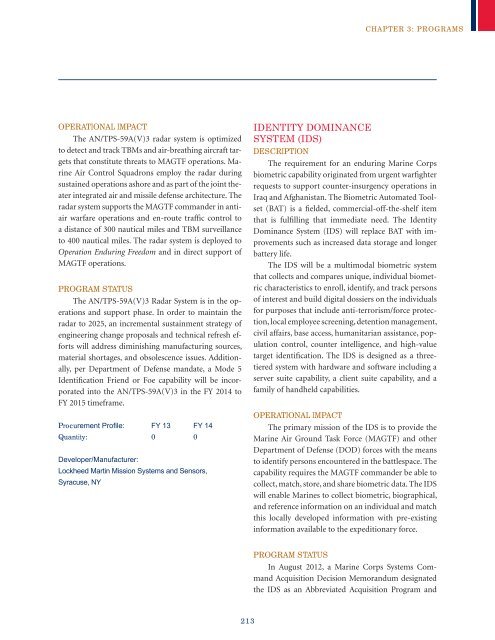USMC Concepts & Programs 2013 - Defense Innovation Marketplace
USMC Concepts & Programs 2013 - Defense Innovation Marketplace
USMC Concepts & Programs 2013 - Defense Innovation Marketplace
You also want an ePaper? Increase the reach of your titles
YUMPU automatically turns print PDFs into web optimized ePapers that Google loves.
chapter 3: programs<br />
Operational Impact<br />
The AN/TPS-59A(V)3 radar system is optimized<br />
to detect and track TBMs and air-breathing aircraft targets<br />
that constitute threats to MAGTF operations. Marine<br />
Air Control Squadrons employ the radar during<br />
sustained operations ashore and as part of the joint theater<br />
integrated air and missile defense architecture. The<br />
radar system supports the MAGTF commander in antiair<br />
warfare operations and en-route traffic control to<br />
a distance of 300 nautical miles and TBM surveillance<br />
to 400 nautical miles. The radar system is deployed to<br />
Operation Enduring Freedom and in direct support of<br />
MAGTF operations.<br />
Program Status<br />
The AN/TPS-59A(V)3 Radar System is in the operations<br />
and support phase. In order to maintain the<br />
radar to 2025, an incremental sustainment strategy of<br />
engineering change proposals and technical refresh efforts<br />
will address diminishing manufacturing sources,<br />
material shortages, and obsolescence issues. Additionally,<br />
per Department of <strong>Defense</strong> mandate, a Mode 5<br />
Identification Friend or Foe capability will be incorporated<br />
into the AN/TPS-59A(V)3 in the FY 2014 to<br />
FY 2015 timeframe.<br />
Procurement Profile: FY 13 FY 14<br />
Quantity: 0 0<br />
Developer/Manufacturer:<br />
Lockheed Martin Mission Systems and Sensors,<br />
Syracuse, NY<br />
IDENTITY DOMINANCE<br />
SYSTEM (IDS)<br />
Description<br />
The requirement for an enduring Marine Corps<br />
biometric capability originated from urgent warfighter<br />
requests to support counter-insurgency operations in<br />
Iraq and Afghanistan. The Biometric Automated Toolset<br />
(BAT) is a fielded, commercial-off-the-shelf item<br />
that is fulfilling that immediate need. The Identity<br />
Dominance System (IDS) will replace BAT with improvements<br />
such as increased data storage and longer<br />
battery life.<br />
The IDS will be a multimodal biometric system<br />
that collects and compares unique, individual biometric<br />
characteristics to enroll, identify, and track persons<br />
of interest and build digital dossiers on the individuals<br />
for purposes that include anti-terrorism/force protection,<br />
local employee screening, detention management,<br />
civil affairs, base access, humanitarian assistance, population<br />
control, counter intelligence, and high-value<br />
target identification. The IDS is designed as a threetiered<br />
system with hardware and software including a<br />
server suite capability, a client suite capability, and a<br />
family of handheld capabilities.<br />
Operational Impact<br />
The primary mission of the IDS is to provide the<br />
Marine Air Ground Task Force (MAGTF) and other<br />
Department of <strong>Defense</strong> (DOD) forces with the means<br />
to identify persons encountered in the battlespace. The<br />
capability requires the MAGTF commander be able to<br />
collect, match, store, and share biometric data. The IDS<br />
will enable Marines to collect biometric, biographical,<br />
and reference information on an individual and match<br />
this locally developed information with pre-existing<br />
information available to the expeditionary force.<br />
Program Status<br />
In August 2012, a Marine Corps Systems Command<br />
Acquisition Decision Memorandum designated<br />
the IDS as an Abbreviated Acquisition Program and<br />
213

















